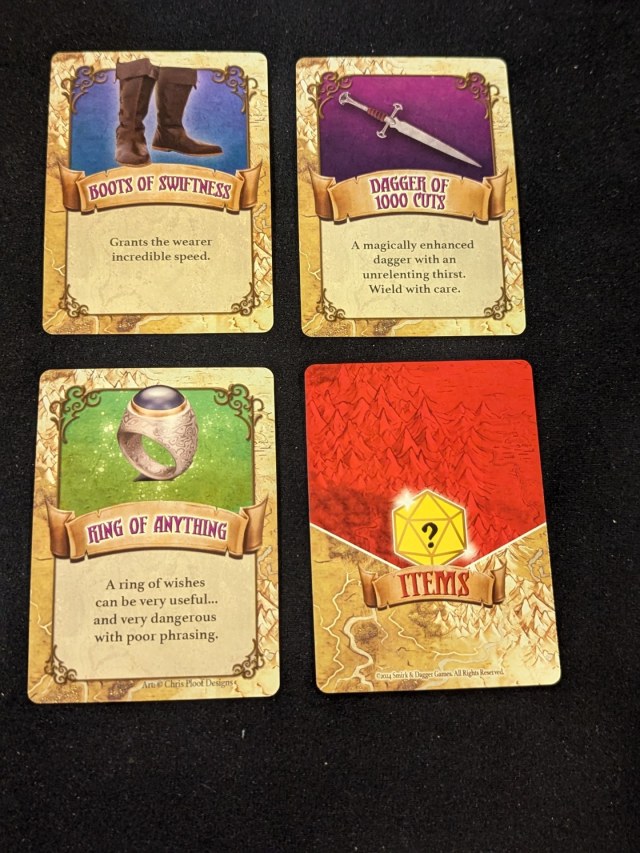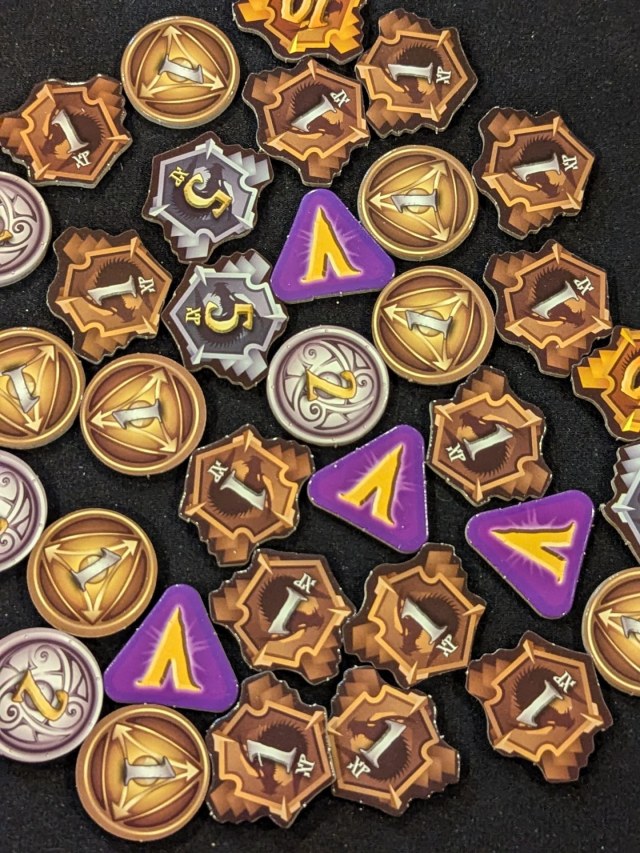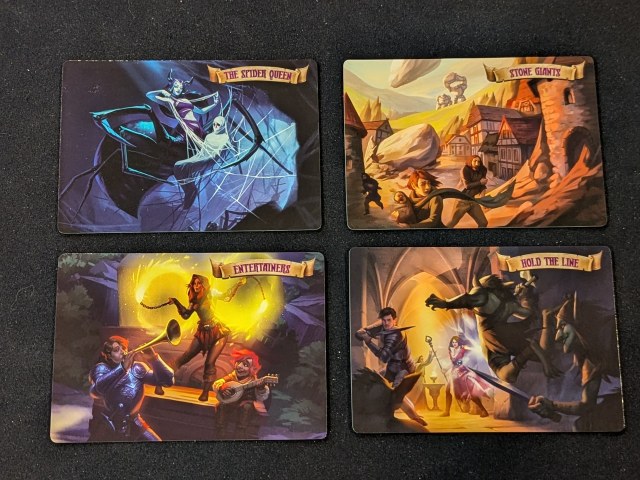Adventure Party: The Role-Playing Party Game
- Designer: David Smith and Travis Winstead
- Publisher: Smirk & Dagger Games
- Players: 3-8
- Age: 14+
- Time: 20-60 minutes
- Played with review copy provided by publisher
Adventure Party delivers a robust role-playing experience that can be enjoyed within 2 minutes of explanation. In this cooperative guessing game, 3-6 players take the roles of adventurers in a classic fantasy role-playing world, facing monsters and attempting heroic deeds. Over the course of 3 Adventure scenarios, the party will work together and collectively attempt to score the most Experience Points possible. Players will take turns, rolling their 20-sided die in secret. Based on how well or poorly they rolled, they will describe what their character does; first outlining their plans and then describing the outcome of their actions. The goal of which is to provide enough detail so that the GM for that turn can GUESS the number they rolled as closely as possible, earning the entire party Experience Points.
To start the game, each player chooses a Character, taking the screen and die for that character. Also take a character sheet where you can pick a couple of traits for your Character – this might help you come up with a story on how your Character will react to events in the game. Each player is also dealt 2 Item cards that they keep to themselves. The group also should decide how long they would like to play – deciding between 1 and 3 Adventure scenarios to play through. You can either choose specific Adventures to play or shuffle the deck and let Lady Luck decide!
Each player rolls their die and the high roll becomes the initial GM (Guess Master). That player then takes the first Adventure card and reads it aloud to the group. After this, play moves to the next player clockwise – who then chooses one of the two Item cards in his hand to use.
Being sure to use this Item card, the player develops a plan for what he would do in response to the story on the adventure card, and then clearly set out the goals of his intended actions. The item card describes the magic power associated with it, so be sure to include the use and effect of the item in your story. If you need help, be sure to refer to your character screen and character sheet as they will give you skills that your Character is probably good at.
Now, the active player rolls their d20 behind their screen. If desired, a player can use a Valor Token to re-roll their die. Now, based on the number rolled, the player now tells everyone what actually happened:
- A “1” is a complete and total failure. Probably things end up the opposite as you had desired. Be sure not to end the story (no one in the party dies…)
- A “9” is just barely a failure while a “10” is just barely a success.
- A “20” is a stunning success where everything went as planned with even some unexpected success. Be sure not to end the story (i.e. do not kill the monster)
You can figure out where any other number fits in this spectrum of 1-20. Try to tell your tale in a story, using enough description so that the GM can guess what number you rolled. Once you are done with your story, the GM is allowed to ask a single question to clarify your answer, trying to suss out the identity of your number.
Now, all the other players turn their die to the number they think was rolled this turn. When all have set their die, the GM announces their guess and then explains why they chose that number. If the GM guesses the number exactly, the team scores 5 Experience points. For each number away, subtract 1 XP from the scored amount. Collect all the XP in a pile in the center of the table. Each non GM-player also can score individual glory, scoring 2 points if they guessed the number exactly or 1 point if they missed by 1. These personal points are kept near the player.
Now, the player who just told the story becomes the next GM and the game continues. The next player continues the adventure story where it ended from the first player. Continue this process until all players have had the chance to be the GM in this adventure. The final person in the round has the ability to end the story as he tells his tale of woe (or success).
After you have completed the chosen number of Adventure cards, the game ends. Total up all your XP and divide by the number of players. Use this calculated value against the chart in the rules to see how you did. The player with the most personal Glory points gets the honor of telling a short story to conclude the adventure.
My thoughts on the game
So, as it turns out, a lot of boardgames cut their teeth on RPGs in their past. For reasons, many people have moved from exploring dungeons and killing dragons to pushing cardboard chits around the board. Adventure Party gives you a chance to revive your story telling chops and return to the world of (mis)adventure.
Unlike a regular RPG, no one needs to spend weeks preparing to be the Dungeon Master. Here, the story is started on a short Adventure card, and then after that, it’s just up to the imagination of the players in the game to further the story. The Character abilities and the Item cards will serve as focus points for the story – so that you don’t have to come up with the whole story on your own. The magic items (and their intended use) give players a really good way to delineate what a successful use would be, and then the resulting story can help get the other players to guess the right number.
While the game has a chart at the end of the rules to determine success – I’ll be honest with you; this isn’t the sort of game that I’d worry about that. The fun here is in the creation and telling of the stories – and the laughs generated as the story unfolds. Interestingly, I find it better (and funnier) to roll a low number here. I find it much easier to tell a tale of woe to describe my relative amount of failure than figuring out how to describe a middling success.
If you’re an old RPG player, you’ll quickly fall into the story telling rhythm of this game, and you’ll likely enjoy reminiscing those long sessions of yore. If you’ve never played a full RPG, this is a pretty good way to see how you like story games. Sure, it’s not nearly the same as a D&D campaign; but you also can’t play that in 20-30 minutes. Use this to see how you feel about telling stories as the game, and maybe you’ll find something new that you like. And, umm, if you hate storytelling games, you’re probably not even reading this review any more, and you don’t need me to tell you that this game is clearly not for you.
Until your next appointment,
The Gaming Doctor








Great review. Thanks! Interestingly, we never describe this as a storytelling game, but rather as a clue giving game. Obviously you are telling a story, but unlike storytelling games, you are not judged on creativity or humor or being the best storyteller. You are rewarded for being a great clue giver. Being able to guide players to what number you rolled, which is a different skill – and one that seems to be less intimidating for people, based on our plays. Anyway, thanks again for sharing your insights! – Curt
Curt – I agree that it is storytelling adjacent. I think there is a genre of party game that requires the players to be creative on the spot. Codenames requires player to create clues but Apples-to-Apples does not because you have a hand of cards. In that sense, if you don’t like being forced to create content on the spot, this won’t be the game for you. Clue-giving and storytelling are both in this user-generated content zone.
I’d be very curious to hear what other story-telling games you’ve encountered that you would recommend. We love Once Upon a Time.